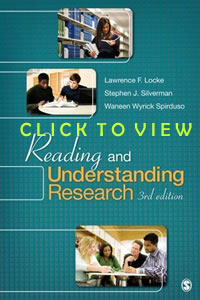|
 Reading
and Understanding Research - 3rd Edition
(2010) Reading
and Understanding Research - 3rd Edition
(2010)
ISBN: 978-1-4129-7574-2
Description: Paperback, 291pp, Copyright
2010
Publishing Company: SAGE Publications,
Inc.
Authors: Lawrence
F. Locke, Stephen J. Silverman, &
Waneen Wyrick Spirduso
Reviewer: Michalis
Stylianou, Ph.D. student, Mary Lou Fulton
Teachers College, Arizona State University
Complete Reference:
Locke, L. F., Silverman, S. J., &
Spirduso, W. W. (2010). Reading and
understanding research (3rd ed).
Thousand Oaks, CA: Sage.
Target Audience/ Purpose:
People decide to read research for different
reasons. All graduate students are required
to engage in the task of reading research
reports to meet the demands of their programs.
A significant number of teachers read
research studies to expand their knowledge
and practices, stay up to date with innovations
in their field, and enhance their effectiveness.
Ordinary people decide to read research
reports because they suddenly need to
be informed about something on a scientific
basis.
Regardless of the reason people decide
to take on the task of reading research
reports, they need to start from somewhere.
"Reading and Understanding Research"
by Locke, Silverman, and Spirduso (2010)
is a prominent source of guidance for
everyone who decides to take on the -
sometimes intimidating - task of reading
research.
Strengths: Why is it
so great? Probably because it is based
on the extensive experiences of three
highly active consumers, producers, and
teachers of research in the field of physical
education, who know as much as anyone
about what it takes to read and understand
research.
One of the book's major strengths lies
in the fact that it seeks to accommodate
the needs of the broad range of potential
readers in several ways.
First, as the authors state in the preface
of the book, it was designed to be used
either as a stand-alone tutorial or as
a supplement to the experiences provided
within a research source. Second, throughout
the book, the authors encourage and facilitate
a flexible navigation through the different
chapters. Third, the authors provide readers
with lists of other resources/ references
about related issues that extend beyond
the purpose of the book. Actually, Appendix
A in the book provides an annotated bibliography
of supplementary references that might
be helpful to the readers.
Content: In short, the
book is divided in four major parts: (I)
The Nature and Uses of Research Reports,
(II) Quantitative Research, (III) Qualitative
Research, and (IV) Reading Research Reviews.
The book also consists of two Appendices:
(A) Annotated Bibliography of Supplementary
References, and (B) Statistics: A Beginner's
Guide. Throughout the book, the authors
present the different research paradigms,
but also make sure to convey the message
that the nature of conducting research
studies is very complex and that tidy
categories do not exist in the real world.
The book provides a variety of tools
(recording forms, exercises, checklists,
tables, etc) that guide the readers through
selecting research reports to read, reading
- or better studying - reports critically,
identifying potential problems or flaws,
explaining research reports (as a way
to learn how to read and understand research),
identifying different research paradigms,
and recording reports of different kinds.
Based on personal experience, the 12-step
forms for quantitative, qualitative, and
review research reports are very useful
in helping readers to navigate through
the reports and stay organized when reading
them.
Summary: On the whole,
the book is very thorough, provides a
good progression of content as well as
flexibility in navigating through the
chapters, and can address the needs of
the broad range of potential readers.
Most importantly, when readers finish
the book, they feel justified with their
choice because they are actually able
to read and understand research.
Recommendation: A must
read for those beginning to read and understand
research reports. Highly
recommended.
|



